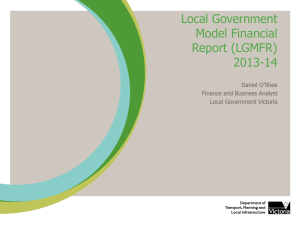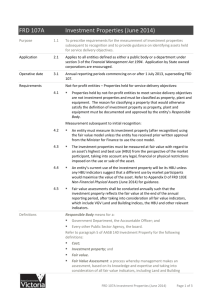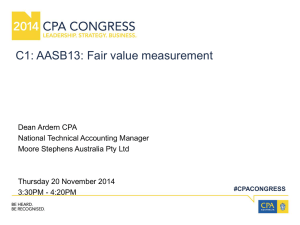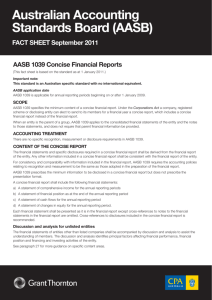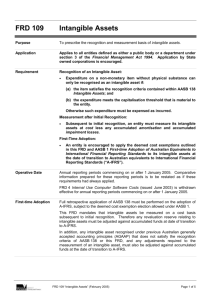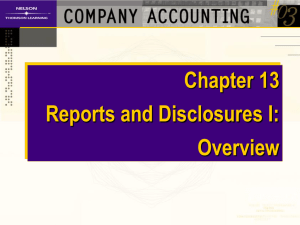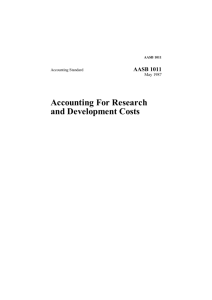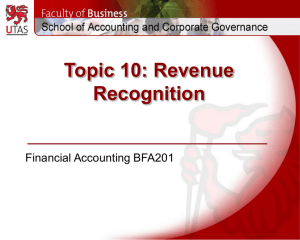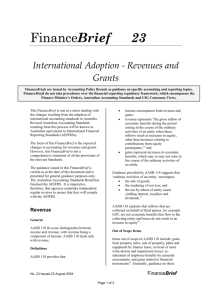RMG 109 - Department of Finance
advertisement
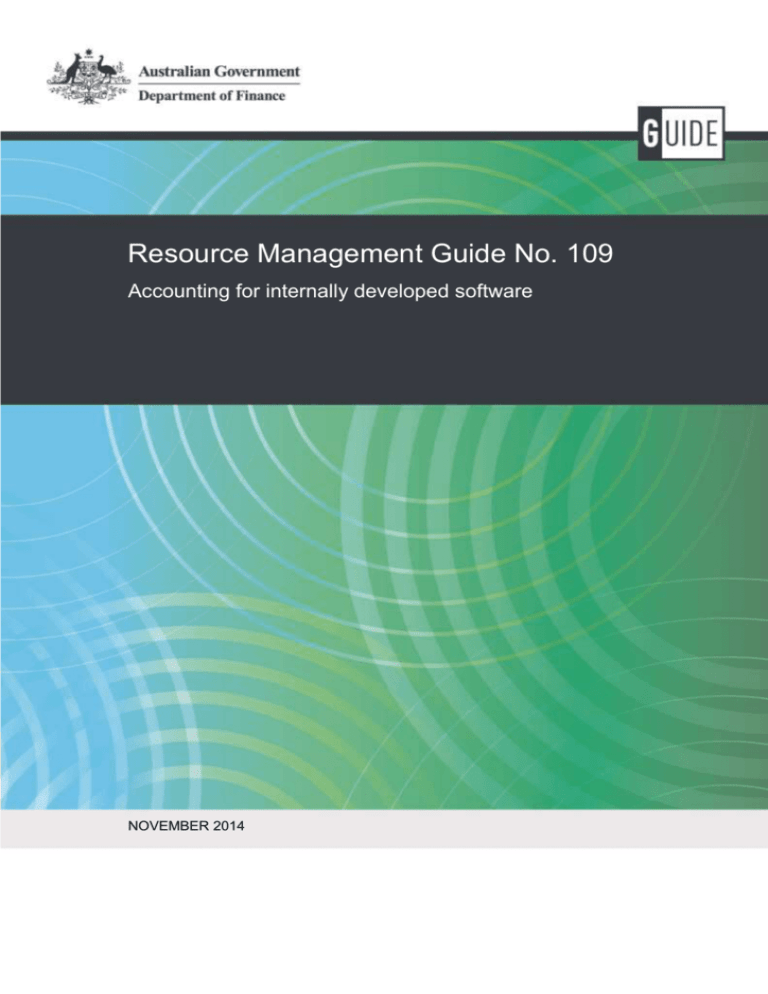
Resource Management Guide No. 109 Accounting for internally developed software NOVEMBER 2014 © Commonwealth of Australia 2014 ISBN: 978-1-925205-02-2 (Online) With the exception of the Commonwealth Coat of Arms and where otherwise noted, all material presented in this document is provided under a Creative Commons Attribution 3.0 Australia (http://creativecommons.org/licenses/by/3.0/au) licence. The details of the relevant licence conditions are available on the Creative Commons website (accessible using the links provided) as is the full legal code for the CC BY 3 AU licence. Use of the Coat of Arms The terms under which the Coat of Arms can be used are detailed on the following website: www.itsanhonour.gov.au/coat-arms. Contact us Questions or comments about this guide should be directed to: Public Management Reform Agenda Department of Finance John Gorton Building King Edward Terrace Parkes ACT 2600 Email: pmra@finance.gov.au Internet: www.pmra.finance.gov.au This guide contains material that has been prepared to assist Commonwealth entities and companies to apply the principles and requirements of the Public Governance, Performance and Accountability Act 2013 and associated rules, and any applicable policies. In this guide the: mandatory principles or requirements are set out as things entities and officials ‘must’ do; and actions, or practices, that entities and officials are expected to take into account to give effect to those and principles and/or requirements are set out as things entities and officials ‘should consider’ doing. Audience This Guide applies to: CFOs and CFO Units in all Commonwealth entities that internally develop software for internal use. This guide is designed to be read in conjunction with the relevant Australian Accounting Standards. Key points Purpose: To provide guidance on what costs can be capitalised for internally developed software intended for internal use. Scope: Focuses on software that is internally developed for internal use (not for the purpose of selling, nor software that is externally developed). Aim: To provide non-mandatory explanation and examples relating to the interpretation and application of Australian Accounting Standards and the PGPA Financial Reporting Rule (FRR) to the above entities. Reference previous guidance: This guide replaces Accounting Guidance Note No. 2007/1. Resources This guide is available on the Department of Finance website at www.finance.gov.au. Applicable accounting pronouncements AASB 138 Intangible Assets AASB 116 Property, Plant and Equipment Contact information For further information or clarification, please email Budget Estimates and Accounting (BEA) at accountingpolicy@finance.gov.au. Guidance What is internally developed software (IDS)? 1. “Internally developed software (IDS)” (see ‘Definitions used’ below) can either be entity developed or where purchased, significantly modified by the entity. Practical guidance For example, SAP systems are designed and modified by SAP and therefore would unlikely meet the definition. Is IDS accounted for under AASB 116 or AASB 138? 2. IDS is an “intangible asset” (see ‘Definitions used’ below) and would be accounted for under AASB 138 unless it is a component of an asset that has a significant physical component, such that the asset could not operate without the software (in which case, AASB 116 would apply). Resource Management Guide 109 Accounting for internally developed software | 1 Practical guidance AASB 138 paragraph 4 provides examples in identifying whether the intangible or tangible (physical) component is significant. Entities may need to consider Interpretation 132 Intangible Assets – Web Site Costs if such issues are applicable. What costs can be capitalised? 3. The development of IDS is divided into two stages, a research stage and a development stage. Research stage Development stage 4. All costs incurred during the research stage are expensed when they are incurred. This stage includes activities aimed at obtaining knowledge, evaluating alternatives and making selection decisions. Research stage Development stage 5. Costs incurred during the development stage are capitalised if they meet the requirements set out in AASB 138, otherwise the costs are expensed. This stage includes activities that relate to design, construction and testing prior to the asset being available for use. 6. There are specific requirements, in addition to those required for intangible assets, before costs arising from the development stage can be capitalised. These requirements are contained within AASB 138 paragraph 57. Practical guidance As the scope of this Guide is on “internal use” (see ‘Definitions used’ below), an entity would focus on the ‘to use’ aspects of the abovementioned requirements and not the ‘to sell’ aspects (e.g. an entity would not be required to demonstrate the existence of a market in AASB 138.57(d) but would be required to demonstrate the usefulness). Costing IDS 7. The cost of an internally developed intangible asset comprises all directly attributable costs necessary to create, produce, and prepare the asset to be capable of operating in the manner intended by management from the date when the intangible asset advances into the development stage. Practical guidance If an entity cannot distinguish which stage a cost related to the project was incurred in, then this expense is treated as if it were incurred in the research stage. Entities should note that there can be a considerable level of judgment involved in the determination of costs as ‘capital’ or ‘expense’ and it is advisable that entities consult their auditors as part of this process. 8. Entities are required to have sufficiently robust costing systems to ensure these costs can be measured reliably because the asset must be initially measured at cost. Practical guidance For example, an entity should have costing systems to measure the costs of employee benefits that can be attributed to the cost of development. Resource Management Guide 109 Accounting for internally developed software | 2 9. AASB 138 disallows costs that have previously been expensed to be capitalised at a later date. Practical guidance Where an item has been classified as an expense in error, it can be subsequently capitalised during the same financial year (provided the recognition criteria in AASB 138 were met when the error occurred). 10. Appendix 1 provides a table outlining examples of project costs allocations between expensing and capitalising costs where there is an internally developed intangible asset. Appendix 2 provides an illustrative exercise on whether to expense or capitalise. Subsequent accounting 11. IDS is carried in accordance with the requirements of AASB 138 and section 17 of the FRR. Practical guidance AASB 138 refers to the term ‘amortisation’. This, in effect, has the same meaning as ‘depreciation’. It is highly unlikely that IDS will be carried at fair value because AASB 138 requires reference to an ‘active market’ for fair value measurement to apply, and under most circumstances, it would be unusual for there to be an ‘active market’ for such IDS. 12. Following the completion and implementation of IDS, only rarely will subsequent expenditure be recognised in the carrying amount of the asset. Usually subsequent expenditure will be expensed. 13. Similar to other non-financial assets, IDS is subject to impairment (write-down) if the economic benefits of the system are unlikely to be realised in accordance with AASB 136 Impairment of Assets. Entities should be aware that: intangible assets not yet available for use should be tested for impairment annually; and initially recognised intangible assets should be tested for impairment before the end of the current annual period. Disclosure requirements 14. Disclosure of IDS (where an intangible asset) is as required by the non-financial assets note in PRIMA Forms and AASB 138 paragraphs 118 to 128. Budget implications 15. The following table illustrates the impact on budget aggregates at the research and development stages*, and for impairment: Transaction Fiscal Balance Underlying Cash Balance 1. Research stage – expensing Worsen (operating expenses reduce net operating balance) Worsen (payments for employees and services are treated as an operating cash outflow) 2. Development stage – capitalising (Work in progress/ asset under construction) Worsen (due to movement in non-financial assets (NFAs)) Worsen (investments in NFAs are treated as a cash outflow) Resource Management Guide 109 Accounting for internally developed software | 3 Transaction Fiscal Balance Underlying Cash Balance 3. Capitalised as an operational/ depreciable asset Worsen (due to movement in NFAs) Worsen/Nil impact (nil impact if no additional cash outflow at this stage, otherwise same as above) 4. Impairment – write down of the asset Nil impact (no impact on net operating balance from operations or NFAs) Nil impact (no cash inflow/outflow) *There is a convergence difference between Australian Accounting Standards (AAS) and Government Finance Statistics’ (GFS) in relation to research and development expenditure. This is because GFS expenses certain development costs and classifies them as expenses from transactions as use of goods and services expenses from transactions even though some development activities are expected to bring benefits for more than one year1, whereas AAS does not recognise all development costs as expenses (as per preceding sections within the Guide). In Budget, an assessment is made as to which treatment is conceptually superior. Definitions used 1 Intangible assets are identifiable non-monetary assets without physical substance (AASB 138.8). Internally developed software is software developed by the entity, or that is purchased by the entity but is significantly modified, for internal use. Internal use is where there is no substantive plan in existence, or being developed, to market the software externally during the software’s development. Refer AASB 1049 Whole of Government and General Government Sector Financial Reporting Explanatory Notes Supporting Illustrative Examples A and B. Resource Management Guide 109 Accounting for internally developed software | 4 Appendix 1 Examples of Project Costs Allocations The below list is not exhaustive and assumes the requirements to capitalise have been met. Expense Software – Capital (AASB 138) Plant & Equipment – Capital (AASB 116) Research stage User testing of existing software to inform a business case Consultant fees Staff costs Development stage Off-the-shelf system Consultant fees – design & construction Depreciation of software licences & computers – specifically required to develop or test the asset Equipment other (printers, PC’s, etc) Data migration costs – test data used for system testing Data migration costs – outside of system testing Project manager costs – planning data migration and/or training Staff costs (including project managers) – development &/or testing Contractor & supplier costs – development &/or testing Staff costs (including project managers) – not directly related to the project (e.g. attending training) Administration costs – not directly related to development Project governance committees Stakeholder meetings Initial pilot system to test feasibility prior to developing the final system to be capable of being used by the entity Inefficiencies in development (e.g. if an entity developed a system to provide functionality of xyz, however a later decision decided to abandon the work on z, the costs related to z could not be capitalised) Implementation stage Replacement of computer terminals – even if the old terminals could not accept the new software Training – staff costs Advertising and promotional costs Manuals (including their development at any stage) Post-implementation reviews Resource Management Guide 109 Accounting for internally developed software | 5 Appendix 2 Illustrative example Expense or capitalise? Information: An entity develops a new IT software program to record customer details. The entity incurred the following costs to develop the new software: (a) $5,000 consultant fees to search and evaluate off-the-shelf systems; (b) $2,000 in employee expenses to select the final off-the-shelf system; (c) $3,000 in employee expenses to design the changes required to the off-the-shelf system; (d) $10,000 in employee expenses to construct and test the new software; (e) $5,000 for new terminals to replace old terminals that did not have the capacity to handle the new software; (f) $500 to promote the new software to staff; and (g) $2,000 in training staff to operate the new asset. Answer: Assuming that the requirements to capitalise have been met, these costs would be treated as outlined below: (a) expense $5,000 consultant fee as it was incurred in the research stage; (b) expense $2,000 employee expenses as it was incurred in the research stage; (c) capitalise $3,000 employee expenses as it is directly attributable and was incurred in the development stage; (d) capitalise $10,000 employee expenses as it is directly attributable and was incurred in the development stage; (e) recognise as property, plant and equipment $5,000 under AASB 116; (f) expense $500 as it is an operating expense incurred in the implementation stage; and (g) expense $2,000 as it is an operating expense incurred in the implementation stage. Resource Management Guide 109 Accounting for internally developed software | 6
